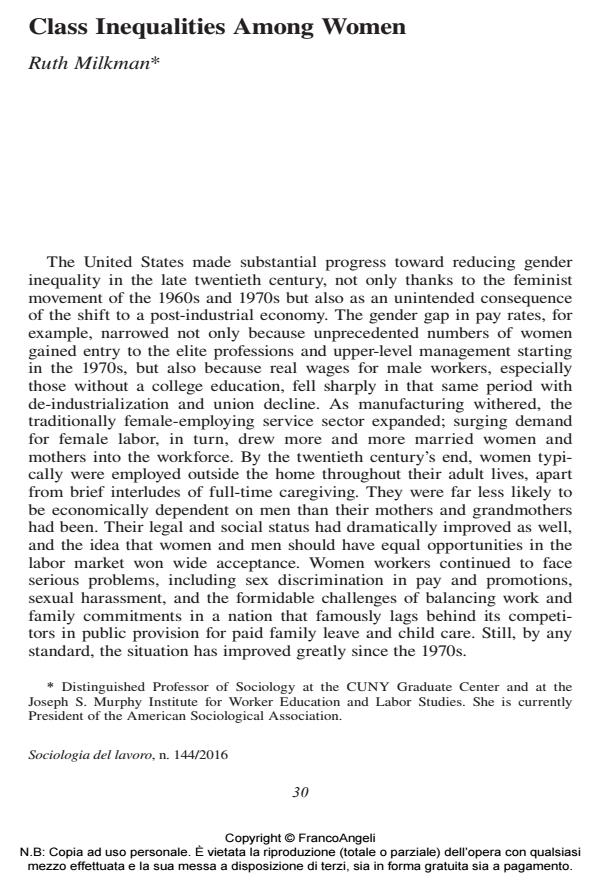Class Inequalities Among Women
Titolo Rivista SOCIOLOGIA DEL LAVORO
Autori/Curatori Ruth Milkman
Anno di pubblicazione 2016 Fascicolo 2016/144
Lingua Inglese Numero pagine 7 P. 30-36 Dimensione file 79 KB
DOI 10.3280/SL2016-144003
Il DOI è il codice a barre della proprietà intellettuale: per saperne di più
clicca qui
Qui sotto puoi vedere in anteprima la prima pagina di questo articolo.
Se questo articolo ti interessa, lo puoi acquistare (e scaricare in formato pdf) seguendo le facili indicazioni per acquistare il download credit. Acquista Download Credits per scaricare questo Articolo in formato PDF

FrancoAngeli è membro della Publishers International Linking Association, Inc (PILA)associazione indipendente e non profit per facilitare (attraverso i servizi tecnologici implementati da CrossRef.org) l’accesso degli studiosi ai contenuti digitali nelle pubblicazioni professionali e scientifiche
Since the 1970s, gender inequalities have declined dramatically in the USA, but in the same period, class inequalities rapidly widened, with profound implications for both women and men. This article documents the fact that class inequalities among women in the 21st century USA are greater than ever before. Job segregation by gender declined in elite jobs but remained unchanged in working-class jobs. And endogamous marriage and mating further multiplied inequalities among women. Although public concern about class inequality has surged in recent years, the rapid rise in within-group’ inequalities among women has received far less attention.
A partire dagli anni Settanta del Novecento, le disuguaglianze di genere hanno conosciuto una forte riduzione negli Stati Uniti ma ciò è avvenuto a fronte di un notevole aumento delle disuguaglianze di classe per entrambi i generi. In questo articolo le disuguaglianze di classe per le donne del XXI secolo siano arrivate a livelli mai raggiunti prima, negli Stati Uniti. La frammentazione occupazionale di genere è diminuita tra i professionisti ma è rimasta invariata all’interno della classe operaia. Il matrimonio endogamo moltiplica ulteriormente le disuguaglianze tra le donne. Nonostante un crescente interesse politico per le disuguaglianze di genere negli ultimi anni, l’aumento repentino di disuguaglianze intra-categoriali tra donne non ha rievuto l’attenzione dovuta.
Parole chiave:Genere, classe, disuguaglianze, donne, endogamia
Ruth Milkman, Class Inequalities Among Women in "SOCIOLOGIA DEL LAVORO " 144/2016, pp 30-36, DOI: 10.3280/SL2016-144003